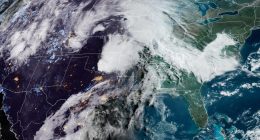
The pandemic is redefining our relationship with space. Not outer space, but physical space. Hot spots, distance, spread, scale, proximity. In a word: geography. Suddenly, we can’t stop thinking about where.
Over the last few centuries new technologies in transportation and communication made geography feel less critical. The advent of railway and refrigerated train cars in the 19th century, for example, had the effect of blurring distances and differences between locations. “Places lost their particularity and became functional abstractions,” wrote William Cronan in his 1992 book, Nature’s Metropolis. The telegraph, telephone, radio, and television each served to push location and distance further and further to the periphery. Then the internet all but obliterated them. Cyberspace, after all, is everywhere and nowhere.
Of course, geography never really died. I’m here and you’re there—boom, geography. Yet in an era when we can fly anyplace, learn anything online, order just about everything from Amazon, and use Google Earth to zoom in on faraway lands, we can get lulled into thinking that our spatial reality amounts to little more than an afterthought.
“Real-world proximity had been receding gradually from our consciousness,” says Erik Steiner, a senior researcher at the Center for Spatial and Textual Analysis at Stanford. “Pandemic throws the importance of space back into sharp relief.” We’re thinking about it at the smallest scale, navigating supermarket aisles or converting closets into serviceable home offices. We’re dealing with it at the regional scale, moving medical equipment from places with surplus to places with need. And we’re watching epidemiologists working at the national and planetary scale, as they race to comprehend precisely how a virus could travel so far so fast and cause such devastation.
Jonathan Mayer, professor emeritus of geography and epidemiology at the University of Washington, says the pandemic underscores, with tragic clarity, why where is so fundamental to our experience. “Pathogens don’t transduce into electrical signals and move through the internet. It’s person-to-person spread,” so naturally people want to know which places have the greatest disease burden and transmission rates. They want to know where the ICU shortages are, where the cruise ships are docked, where to buy masks, and where the testing kits are hiding. Our very safety now depends, at least in part, on geography.
Meanwhile, social distancing has “shrunk everyone’s physical world into an extremely local space,” says Betsy Mason, coauthor of All Over The Map and the cartography website mapdragons.com. (She’s also a former WIRED science editor.) We are operating in tight quarters, yet simultaneously “all too aware of the close connection between local space and the rest of the globe,” Mason says. “Toggling between such different scales can be disorienting, especially when movement through space can feel fraught with danger.”
The pandemic may be altering our idea of home as well. Researching the Spanish Influenza of 1918 and the Ebola outbreaks of 2014 and 2016, Mayer looked at the connection between the pathogen and the idea of elsewhere. “Ebola was regarded as exotic,” he says. “Dangerous, but still over there, until a few cases were detected in the US.” As danger, real or perceived, creeps closer, the notion of safe space narrows, then narrows more, “until it’s really anything outside the home,” Mayer says. I think about this when watching my children, already so heartbreakingly adept at sticking close to home, and wonder when I can once again encourage them to expand their sense of comfortable space, to venture out.
There are even signs that the pandemic is giving everyday interactions a geographic twist: On the telephone or in Zoom meetings, I’m hearing people replace “How are you?” with some version of “How are things where you are?” And checking and rechecking maps has become its own somber ritual, if not compulsion. I was doing exactly that the other morning, when my 7-year-old wandered into my office and glanced at the computer monitor. On seeing the New York Times map, the one with the telltale graduated circles representing Covid-19 cases by state and city, she asked straight away: “Is that the coronavirus?”
The spatial realities of Covid-19 are changing how we live and forcing us to see the world through where-tinted glasses. Yet pandemic’s most valuable lesson, should we finally be willing to receive it, is that the very concept of elsewhere is a fiction. It is naive to think of other places as disconnected from our own geography, our own lives. Where matters—absolutely. But it’s also true that we all live right here. Together.
Photographs: Donat Sorokin/Getty Images; Marco Cantile/Getty Images
More From WIRED on Covid-19










